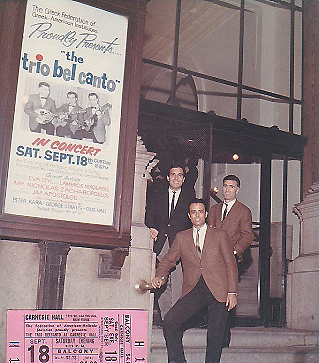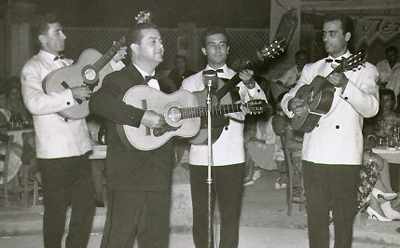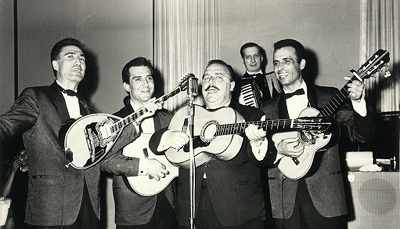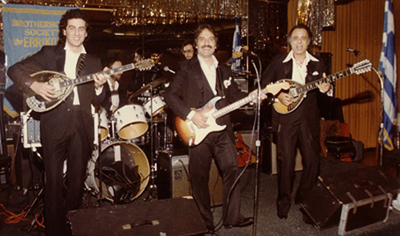
|
TRIO BEL CANTO
To say that the Trio Bel Canto has maintained a unique presence for five decades is an understatement. This masterful Trio has found more ways to remain constantly in demand and sustain audience appeal, bridging it from one generation to another for over half a century. Their playing is as vibrant today as it was when they first began recording. Throughout their successful career, their dedication to preserving the richness of traditional music reinforces their status as a dominant musical presence in the hearts and dancing feet of Greek music lovers.THE NEXT GENERATION By Athan Karras 
Handed down from past generations, Greek music is appreciated and enjoyed as a tradition for music-loving amateurs playing primitive instruments. As one of the earliest civilizations in the Mediterranean, Greece has been endowed with a beautiful musical legacy reflecting each time period's changing attitudes, which in turn reveal the passions of the people. Over time, the Greeks embraced western influences and their primitive instruments were refined with sophisticated adaptations. Musicians in the countryside and islands were the last to defy change, believing that music, song, and dance were the last bastion linking Greeks with their homeland. By the end of World War II, Greece had suffered famine and devastating destruction by the Axis invaders, followed by a divisive and painful civil war. The Greek people, willing to forgive and forego retribution, desperately looked forward to returning to normal peaceful living. Abandoning their devastated villages, the rural population – clamoring for employment opportunities and a more comfortable existence – crowded into the larger cities. While dancing was still reserved for special celebrations,
Post-war Athens also was responding to an international trend toward Latin music, combining a special brand of popular Mexican combraceros with a Mediterranean touch comprised of sweet innocent lyrics that were romantic and catchy. Duets and Trios strolled the narrow paths up to the Acropolis – a haven for young lovers – and found their way to open-air cafes and rooftop terrace tavernas. The music and songs were broadcast on the radio along with the latest European, American and Latin rhythms. Musical variety shows featured young amateur artists eager to turn pro. There were some outstanding talents around: the Trio Cansone, Trio Kitara, and Trio Moreno all contending to entertain audiences with western and Latin rhythms bearing a slight Greek twist. Evangelos Metaxas, John Papamakariou and Bobby Tsombanakis grew up in the humble Athenian neighborhood of Nikaia. Just out of high school, they enjoyed making music while relaxing on their stoops in the late afternoons. As amateur musicians with a penchant for the latest radio tunes, they quickly reproduced popular songs while experimenting with their own version of harmony. Their neighbors were delighted with what they heard and encouraged the boys to go professional. Based on a teenage fanasy of three nutty cowboys wearing wide sombreros riding horseback "down Mexico way," they adapted a Latin song called "Coumbatsero" and soon everyone was calling them Trio Coumbatsero. Here they were: three young Athenians without horses or sombreros, but with a passion for harmonizing. They came to the attention of pianist Vagelis Lykiardopoulos who arranged for the boys to present their Latin repertoire Lykiardopoulos who arranged for the boys to present their Latin repertoire in a variety show at the famous Alsos Park at Pedion tou Areos in Athens where they tantalized the audience. The ecstatic encouragement of the public led to renaming the group Oi Filoi Tou Bel Canto (The Friends of Beautiful Song). They cut their first single under the helm of composers Mimis Plessas and Giorgos Mouzakis at a time when young teenage vocal duets and trios were appearing overnight like mushrooms. Their Latin-American/Greek beat was attractive and
Demands for appearances – including live radio – were mounting. With the support of producer Giorgos Economidis they joined the Giorgos Economidis they joined the Giorgos Mouzakis Orchestra, which brought them to the forefront of the Alsos Musical Reviews. Later they joined maestro Lycourgos Markeas and Alsos Musical Reviews. Later they joined maestro Lycourgos Markeas and their Athenian fan club was on the march. Imitation groups trying to emulate their bel canto style of harmony were being formed. During the early fifties elafri mousiki (light music) romantic lazy tunes and simple flirtatious ditties dominated the airwaves and entertainment centers. The Trio's popularity was on a roll; offers were pouring in for appearances in Greek films and tours throughout Greece and Cyprus. Their style was now reminiscent of the popular Athenian cantades from the turn of the century first made famous by the Ionian Island style of harmonic singing, particularly the mellow harmony found in Cephalonia. In the '50s, they extended their tour to the Near Eastern hubs of expatriate Greeks, and for the first time – to foreign audiences. Concert requests began pouring in from European capitals and by 1956, the George Mouzakis Orchestra engaged them for an excursion on the Greek ocean liner Queen Frederica. Bobby Tsombanakis was replaced with Michael Matheos, and the Trio sailed for America at the invitation of the AHEPA organization. The golden period for the Trio was beginning with nightly shows at famous Greek supper clubs in New York, and weekends at Greek horoeperides (Greek American dinner dances.) In the early '60s, they received an invitation to perform at the famous Greek resort hotel Monte Carlo in the Catskill Mountains with the popular entertainer and troubadour Nico Gounaris. This was my first exposure to the Trio in person and to the liveliest upbeat music I have ever witnessed. The evening concerts at the Monte Carlo became the rage, paving the way for new directions in Greek dance music. The Monte Carlo was swamped with guests arriving at the mountain resort from all over. They were razzle dazzled by Nico Gournaris' velvet voice accompanied by the Trio's touches of Combracero's escapades. With the passing of Nicos Gounaris, the Trio headlined with the top Greek American orchestras of Gus Vali and George Stratis. The group's rising popularity caused them to expand their repertoire to include current bouzouki hits. With the success of motion pictures like Never on Sunday and Zorba the Greek, a new broader acceptance of Greek music emerged in America. Two young post-war composers Manos Hatzidakis and Mikis Theodorakis were becoming spokesmen for artistic musical innovations articulating the soul of Greece and were paving the way for Greek music to gain international distinction. The Trio dove into this new genre reinventing their bel canto style with provocative orchestrations, incorporating the tunes of classic rebetika giving them a sophisticated nuance beyond the raw and austere harshness of the original rebetika sound. The songs were being exposed to new and wider audiences
Recognizing that almost every Greek song is danced to, the Trio dug into old classic folk tunes like Samiotissa, Ena karavi apo tin Hio, Karagouna, and the powerful tunes of the Levendika Tsamika, transforming them by using their unique style and sound. The old-fashioned peasant demotiki (folk) song was unfamiliar to the new generation's growing up in urban communities in Greece as well as to young Greek Americans. The Trio's bel canto style made the old folk tunes readily acceptable to the young. The Trio's success was phenomenal. Not being songwriters and composers, they became masters in interpreting the musical highlights of the past and added the latest Athenian Tin Pan Alley hits to their repertoire, melding a cultural bridge of tradition and the bel canto style producing renditions of soothing, mellow and seductive songs. With an established permanent residence in America, there was a danger of losing touch with musical developments in Greece. They used their connections in Greece to obtain the latest releases so that they could quickly adapt the Greek hits into their unique style. The trends were changing fast, but the Trio would be right there grooving and spinning the latest Athenian tunes with their bel canto touch. During the '60s and '70s, the Trio was inundated with multiple recording deals, most of which became classics. There wasn't a Greek home in the country without a half dozen Trio Bel Canto recordings. The charming romantic Trio became the most celebrated orchestra for Greeks in the Diaspora and was accorded constant invitations for world tours. The Trio's inimitable style of Greek folk music – interpreting the traditional woes of mountain village folk, the lyrical sounds of islanders, or the more soulful longings and sorrowful moods of rebetika – was no longer that of an individual region or genre, instead, it was the collective musical conscience of every Greek in Greece or abroad. Their voices were not intimidating to an audience, so their songs created an open response for fans to join in. Knowing very well how Greeks have a penchant for dancing, their Sing and Dance with the Trio Bel Canto album became a smash hit that provided an outstanding variety of dance music for an entire evening's entertainment. They went on an extensive American to
Rebetika music was capturing the imagination of the Greek nation and was also having a following among non-Greeks. The Trio continued to adapt rebetika songs; a musical genre not initially geared to their gentle bel canto style. In 1971, the Trio faced another change, Michael Matheos decided to take a break from the group and was replaced by a phenomenal bouzouki player Takis Elenis. The Trio was now able to dig deep into rebetika music. They carefully selected songs that could be stylized, and made them palatable to new audiences unaware of the political directions the rebetika "subculture" espoused. The original versions were austere heavy-handed heartrending bouzouki playing with a heavy dose of acrimonious lyrics protesting modern society. The Trio was making its mark with early renditions of Tsitsanis, Markos Vamvakaris, Ioannis Papaioannou, and other famed rebetika composers. When I was directing a special Greek Night produced by Perry Phillips at the Sahara Hotel in Lake Tahoe, the Trio Bel Canto was headlining along with an extraordinary bouzouki soloist Yannis "Sporos" Stamatis. Sporos was a master of the new 8-string bouzouki first introduced by the famous bouzouki player and composer Manolis Hiotis. The show was to open with the Trio doing a medley of nostalgic favorites, setting the mood. Center stage, they took turns As I stood in the wings with Sporos, he turned suddenly to me nearly pounding on my chest as he wailed, "What's he doing out there? Why is he playing that song? It was supposed to be my opening number! What am I going to do now?" Sporos looked ready to smash his bouzouki and quit. I pulled him aside and said "Sporo, you're going to go out there and you're going to use every trick in the book, every heart-tingling emotion you have ever felt, and you're going to let it all hang out on that bouzouki you've lived with every day of your life and make it sing like it never sang before. Well, Sporos did exactly that. Like the pro he was, he went out and executed some incredible penies the likes of which I had never heard before. The evening was a musical experience that only comes about once in decades. It was history in the making. In the '80s, Greek clubs were not doing so well. Greeks were caught in a generation gap and music from Greece was facing disturbing ups and downs trying to imitate worldwide trends in pop and rock. Greek music wasn't identifiable any more. New artists from Greece, restless from the musical upheavals in their home scene, sought an economic advantage through tours. They hit the boards with one-night stands in various American cities. The Trio's monopoly of more than two decades began to fade. They were no longer the new faces on the block. In 1986, Takis Elenis departed to go solo and was replaced by the equally fine bouzouki player George Vlismas. From the middle 1980s through the 1990s what may have appeared as the group's decline was actually a welcomed period of rest. When George Vlisimas left the Trio in the late '90s, Evangelos Metaxas enlisted the talents of his son Kyriakos (Chuck) and the group was revitalized. Competition was fierce and the musical "wars" vying for new contracts, markets, and venues were raging. The Trio had shaped the musical tastes of the Diaspora and now, they returned to Greece seeking to recreate its image. It would be up to veteran Evangelos Metaxas, still not ready to hang up the reins, to get the job done. After a brief visit to Greece, he discovered a vastly different world. It a lesson everyone learns: things never stay the same making it impossible to ever go back. Though they were loved and respected, the musical world in Greece had moved in new directions. It was in America that they shined. Willing audiences still identified with their sound. Evangelos Metaxas, his son Kyriakos Metaxas, and Nick Mandoukos became the next generation Trio Bel Canto. Fans along the way might be tempted to make comparisons with the group's early sounds, but music in any generation speaks to the hearts and souls of audiences willing to listen and once again audiences responded. What are the musical tastes of Greek music these days? At times I find it indistinguishable and unmemorable. The Trio's legacy has been deep and profound, they found their voice in the bel canto, not purely Greek, yet they created a very strong contemporary Greek presence with it and their music became an institution. Music of the past is to be honored and appreciated but even the past traditions need to be updated and brought into the realm of current expression. This is what the Trio did. By mastering the essence of vintage folk songs, they made them current. They became suitable to the harmonized blended experience of today, even to those who grew up with the primitive instruments of the countryside the Trio, in its own way, not only created new music but explored ways to touch the hearts and minds of Greek Americans eager to participate in their cultural heritage. For more information visit the Trio Bel Canto's website and the HCS music pages |
|





